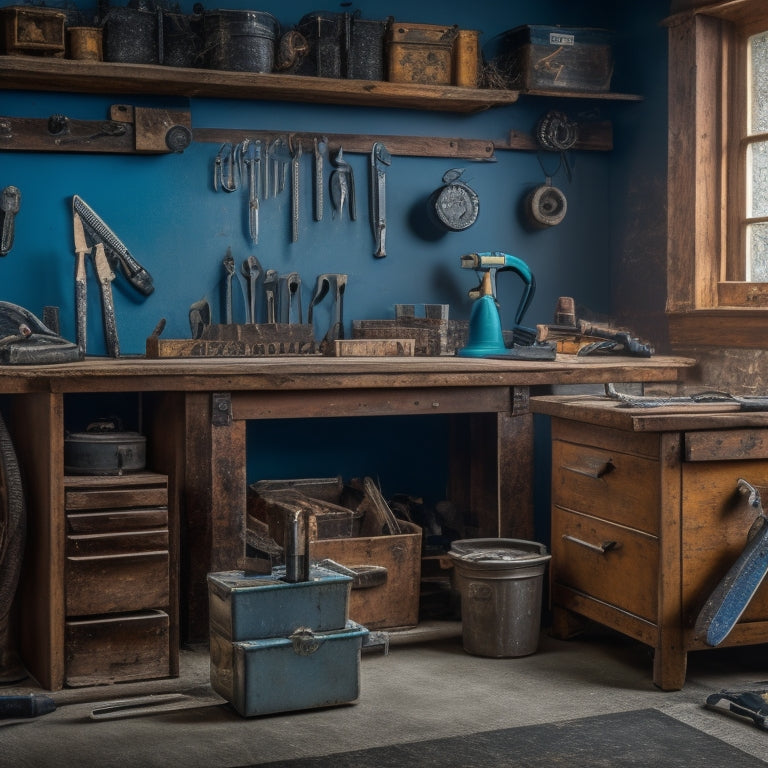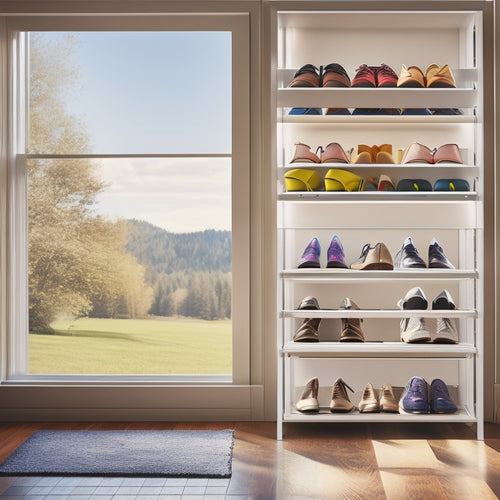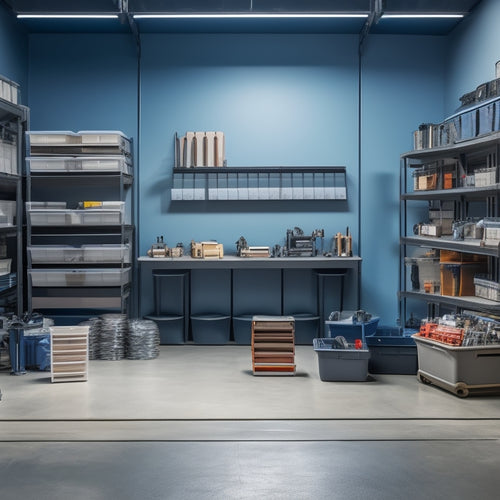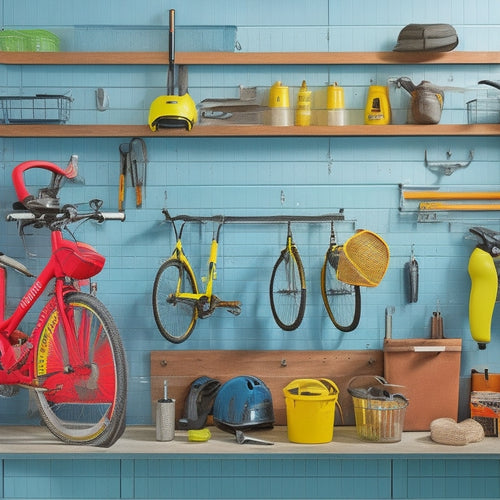
Features to Consider in a Metal Tool Chest
Share
When choosing a metal tool chest, you'll want to reflect on several key features to guarantee you get the right one for your needs. Size and storage capacity are essential, as a well-organized layout can optimize space and access. Material thickness and durability are also significant, with thicker metals and rust-resistant coatings providing better protection. Additionally, think about the locking mechanism and security features, as well as mobility and portability options. Don't forget about rust and corrosion resistance, soft-close drawer slides, and powder coat finish quality. By evaluating these features, you'll find the perfect tool chest to meet your needs and take your workspace to the next level - and that's just the starting point.
Key Takeaways
- Consider the size and storage capacity of the metal tool chest, including adjustable dividers and customizable compartments for efficient space optimization.
- Look for a chest with thick, durable materials (at least 18-gauge) and rust-resistant coatings to ensure longevity and protection against corrosion.
- Evaluate the frame strength, locking mechanism, and weight capacity to ensure the chest can support your tool collection and provide secure storage.
- Consider mobility and portability options, such as wheels and casters, to facilitate easy movement around the workspace or job site.
- Check the finish quality and additional features, such as integrated power strips and adjustable dividers, to customize storage space and enhance functionality.
Size and Storage Capacity
Several metal tool chests boast impressive size and storage capacity, holding up to 30-40 individual drawers, each measuring between 1-6 inches in height.
When selecting a tool chest, you'll want to take into account the storage layout to guarantee it meets your specific needs. A well-organized storage layout is essential for efficient space optimization, allowing you to quickly locate and access the tools you need.
Look for a tool chest with adjustable dividers and customizable compartments to maximize storage potential. You should also take into account the overall size of the tool chest and how it will fit in your workspace. A larger tool chest may provide more storage, but it may also take up important floor space.
Consider a tool chest with a compact design that still offers ample storage capacity. By optimizing your storage space, you'll reduce clutter, improve productivity, and create a safer working environment.
Material Thickness and Durability
You're looking for a metal tool chest that can withstand the rigors of your workshop, and that starts with the material thickness and durability.
The gauge of metal used in the chest's construction is critical, as it directly impacts the chest's ability to resist dents and corrosion.
You'll also want to take into account the rust-resistant coatings applied to the metal and the frame strength, which guarantees the chest remains stable and secure even when fully loaded.
Gauge of Metal Used
When selecting a metal tool chest, the gauge of metal used is a critical factor to evaluate, as it directly impacts the material's thickness and durability.
You want a tool chest that can withstand the rigors of daily use and protect your precious tools from damage. The gauge of metal refers to its thickness, with lower gauge numbers indicating thicker metal.
Look for tool chests made with a minimum of 18-gauge metal, which is a common standard in the industry. However, if you need a more heavy-duty option, consider a 14-gauge or 12-gauge metal tool chest. These thicker gauges provide added strength and resistance to dents and scratches.
Additionally, verify the tool chest meets gauge standards set by organizations such as the American Society for Testing and Materials (ASTM).
Rust-Resistant Coatings Applied
In addition to the gauge of metal used, the rust-resistant coatings applied to a metal tool chest play a vital role in its overall durability and material thickness.
These coatings not only protect the metal from corrosion but also enhance the chest's resistance to wear and tear. When selecting a metal tool chest, you'll come across various coating types, including epoxy, powder coat, and rust-resistant paint. Each type offers a unique level of protection, so it's important to choose one that suits your needs.
To guarantee the coating remains effective, it's imperative to follow proper maintenance tips.
Regularly clean the chest with a mild detergent and dry it thoroughly to prevent moisture buildup. Avoid using harsh chemicals or abrasive materials that can damage the coating. By doing so, you can extend the lifespan of your metal tool chest and maintain its rust-resistant properties.
Frame Strength Matters
Frame Strength Matters
Three key components contribute to a metal tool chest's frame strength: material thickness, durability, and joint construction. When you're evaluating a tool chest, look for a frame design that emphasizes structural integrity.
You want a chest that can withstand the weight of your tools and equipment, as well as any environmental stresses it may be exposed to.
Here are three essential factors to take into account:
-
Material thickness: A thicker material gauge provides added strength and resistance to corrosion.
-
Weld quality: Look for strong, consistent welds that guarantee the frame's joints are secure.
-
Reinforced corners: Additional support at the corners helps prevent damage from impact or heavy loads.
A sturdy frame is critical to the overall safety and performance of your metal tool chest.
It's what keeps your tools organized, protected, and within reach. By prioritizing frame strength, you can trust that your tool chest will serve you well for years to come.
Locking Mechanism and Security
You expect a high level of security from your metal tool chest, and a dependable locking mechanism is crucial to achieving that. A good locking system should be able to withstand forced entry and unauthorized access.
Look for a metal tool chest with a sturdy locking mechanism that incorporates advanced security features. Keyless entry systems, for instance, eliminate the risk of lost or stolen keys. Some metal tool chests also come with integrated alarms that sound when someone tries to break in. These alarms can be particularly useful in noisy workshops or job sites where you may not be able to hear someone attempting to access your tools.
When evaluating the locking mechanism, consider the type of lock used, the material it's made of, and its resistance to tampering. A high-security lock with a hardened steel shackle and anti-pick pins can provide an additional layer of protection.
Additionally, look for locks that are protected by a weather-resistant coating to guarantee they remain functional in harsh environments. By prioritizing a dependable locking mechanism, you can have peace of mind knowing your tools and equipment are safe and secure.
Drawer Organization and Configuration
Configured to optimize your workflow, a well-organized metal tool chest features drawers that are designed to keep your tools and equipment neatly arranged and easily accessible. This thoughtful design guarantees you can quickly locate and retrieve the tools you need, saving you time and reducing frustration.
When evaluating a metal tool chest, consider the following drawer organization and configuration features:
-
Adjustable drawer dividers: Allow you to customize the layout to fit your specific toolset and create separate compartments for small parts and accessories.
-
Tiered drawer layouts: Provide multiple levels of storage within each drawer, enabling you to store more tools and equipment in a compact space.
-
Soft-close drawer slides: Assure smooth, quiet operation and prevent drawers from slamming shut, which can damage tools or cause injury.
A well-organized metal tool chest with thoughtful drawer layouts and configurations can greatly improve your tool accessibility, reducing the risk of accidents and increasing your productivity.
Mobility and Portability Options
When you're shopping for a metal tool chest, you'll want to take into account mobility and portability options that make it easy to move the chest around your workspace or job site.
Wheels and casters can provide smooth, quiet movement, while lightweight construction options can reduce the overall weight of the chest, making it easier to lift and transport.
Wheels and Casters
The metal tool chest's wheels and casters play an essential role in its mobility and portability, allowing users to effortlessly move the chest around the workspace or store it in a convenient location.
When choosing a metal tool chest, consider the type of wheels and casters that will best suit your needs.
-
Wheel types: Pneumatic wheels provide a smooth ride on rough surfaces, while polyurethane wheels are better suited for heavier loads and can withstand harsh environments.
-
Caster materials: Look for casters made from durable materials like steel or aluminum that can support the weight of the tool chest and its contents.
-
Swivel and brake functionality: Verify the casters have a smooth swivel motion and a reliable brake system to prevent the chest from rolling away or getting stuck.
When selecting a metal tool chest, prioritize wheels and casters that provide a stable and secure ride.
This will guarantee you can move the chest safely and efficiently around your workspace, reducing the risk of accidents and injuries.
Lightweight Construction Options
Flexibility is key when it comes to metal tool chests, and a lightweight construction can greatly enhance their mobility and portability.
You'll appreciate the ease of movement when you need to reorganize your workspace or transport your tools to a job site. Look for metal tool chests made from lightweight materials like aluminum alloy, which provides exceptional strength-to-weight ratio without compromising durability.
A compact design also contributes to a more portable tool chest, allowing you to fit it into tight spaces and maneuver through narrow corridors.
When evaluating lightweight construction options, consider the weight capacity and distribution of your tools. Ascertain the tool chest is designed to handle the weight of your equipment and can withstand the rigors of frequent movement.
Weight Capacity and Load Rating
As you consider investing in a metal tool chest, evaluating its weight capacity and load rating becomes essential to confirm it can handle your tool collection's collective weight. You wouldn't want your tools to be scattered all over the floor due to a chest that can't support their weight.
To confirm your tool chest can hold everything you need, look for the following:
-
Weight distribution: A well-designed tool chest should have a weight distribution system that allows you to organize your tools evenly, preventing any single point from becoming too heavy.
-
Load testing: Check if the manufacturer has conducted load testing to confirm the chest can handle the maximum weight capacity. This testing should include static and fluctuating load tests to replicate real-world scenarios.
-
Weight capacity ratings: Verify the weight capacity ratings of individual drawers, shelves, and the entire chest. This will give you an idea of how much weight each component can handle.
Rust and Corrosion Resistance
Your metal tool chest will likely be exposed to harsh environments, humid conditions, and potential spills, making rust and corrosion a significant concern. As you consider a metal tool chest, look for rust-resistant coatings, such as powder coating or rust-resistant paint, to protect the metal from environmental factors.
Additionally, consider a chest with a rust-resistant interior, which can help prevent the spread of corrosion if a tool or equipment is left in a damp or wet state.
Regular preventive maintenance is also essential in preventing rust and corrosion. Make it a habit to wipe down your tools and the interior of the chest regularly to remove any moisture or debris.
You should also make sure the chest is properly sealed when not in use to prevent moisture from entering.
When shopping for a metal tool chest, check the manufacturer's specifications for rust and corrosion resistance. Some chests may have additional features, such as drainage holes or rust-resistant liners, to help prevent corrosion.
Soft-Close Drawer Slides
By confirming your metal tool chest can withstand harsh environments, you've taken the first step in maintaining a reliable storage solution.
Now, it's crucial to evaluate the type of drawer slides used in your tool chest. Soft-close drawer slides are an important feature to look for, as they provide a safe and convenient way to access your tools.
Soft-close drawer slides offer several benefits, including:
-
Reduced noise: Soft-close slides eliminate the loud banging noise associated with traditional drawer slides, creating a more peaceful working environment.
-
Increased safety: By slowing down the drawer's closing motion, you're less likely to pinch your fingers or damage your tools.
-
Improved durability: Soft-close slides reduce the wear and tear on your tool chest, extending its lifespan.
When installing soft-close drawer slides, be certain to follow the manufacturer's installation tips to guarantee proper alignment and smooth operation.
Proper installation will assure you reap the full benefits of soft-close technology, providing a seamless and safe experience when accessing your tools.
Powder Coat and Finish Quality
How do you guarantee your metal tool chest withstands the rigors of a harsh workshop environment? A high-quality powder coat and finish are crucial to protecting your investment from corrosion, scratches, and fading.
Look for a tool chest with a thick, uniform powder coat that resists chipping and flaking. A durable finish also helps prevent rust and guarantees your tools remain clean and dry.
When selecting a metal tool chest, consider the color variety available. A range of colors can help you match your tool chest to your workshop's aesthetic or personal preferences.
Additionally, a high-quality finish should be easy to clean and maintain. Follow simple maintenance tips, such as wiping down the tool chest with a damp cloth and avoiding harsh chemicals, to extend its lifespan.
A superior powder coat and finish not only enhance the tool chest's appearance but also provide a safe and reliable storage solution for your important tools.
Additional Features and Accessories
Beyond the fundamental aspects of a metal tool chest, additional features and accessories can considerably enhance its functionality and user experience.
You'll want to take into account the customization options and accessory compatibility that can tailor the tool chest to your specific needs.
-
Integrated power strips: Many modern tool chests come with built-in power strips, allowing you to keep your tools charged and within reach. This feature is especially useful for tools that require frequent charging, such as cordless drills and saws.
-
Adjustable dividers and organizers: Adjustable dividers and organizers enable you to customize the storage space to fit your unique toolset. This guarantees that your tools are neatly organized, reducing the risk of damage and making them easier to access.
-
Locking mechanisms and security features: Look for tool chests with sturdy locking mechanisms and security features to protect your prized tools from theft or unauthorized access. This is particularly important for users who work in high-risk environments or store their tool chest in a shared space.
Frequently Asked Questions
Can a Metal Tool Chest Be Used for Outdoor Storage?
You can use a metal tool chest for outdoor storage if it's designed with weather resistance in mind, such as rust-proof coatings and waterproof seals, and consider portability options like wheels or handles for easy relocation.
Are Metal Tool Chests Compatible With All Types of Tools?
You'll find that metal tool chests are generally compatible with most tool types, but you'll need to take into account tool organization and storage solutions to guarantee safe, efficient access and prevent damage to your equipment.
Can a Metal Tool Chest Be Customized With a Logo?
You can customize a metal tool chest with your logo using various branding options and customization techniques, such as laser engraving, silk screening, or powder coating, to create a unique and professional look that reflects your brand identity.
Do Metal Tool Chests Require Regular Maintenance to Last Long?
As you wield your tools like a skilled artisan, remember that your metal tool chest is only as strong as its upkeep; regular rust prevention and tidy interior organization will guarantee it remains your trusted sidekick for years to come.
Are Metal Tool Chests Covered Under a Manufacturer's Warranty?
You should expect a metal tool chest to come with a manufacturer's warranty, typically ranging from 1-5 years, covering defects in materials and workmanship, with varying warranty duration and coverage depending on the brand and model you purchase.
Conclusion
Now you've got the inside scoop on the must-have features in a metal tool chest. But, here's the thing - the perfect tool chest is still out there, waiting for you to find it. Will you settle for subpar storage or insist on superior durability? The fate of your tool collection hangs in the balance. The search continues, but with these features in mind, you're one step closer to unearthing the ultimate metal tool chest that'll keep your tools safe and organized for years to come.
Related Posts
-

Adjustable Modular Shoe Racks for Versatility
Adjustable modular shoe racks are your go-to solution for versatile and organized footwear storage. These racks maxim...
-

How to Maximize Storage Space With Parts Storage Bins
To maximize storage space with parts storage bins, start by evaluating your available storage space and examining you...
-

Benefits of Pegboard Racks in Your Garage
By installing a pegboard rack in your garage, you'll reveal a wealth of benefits that change your workspace into a hi...


